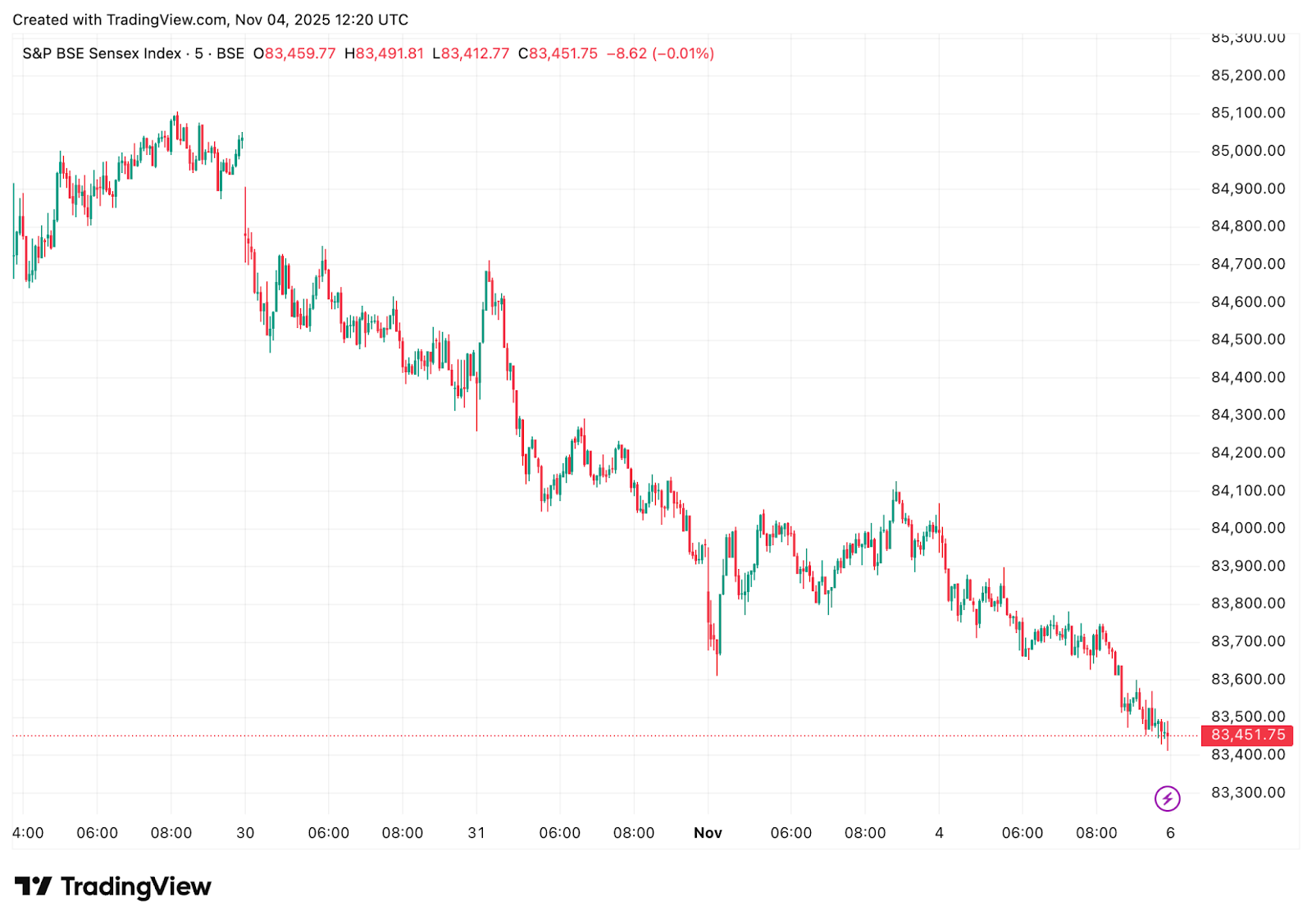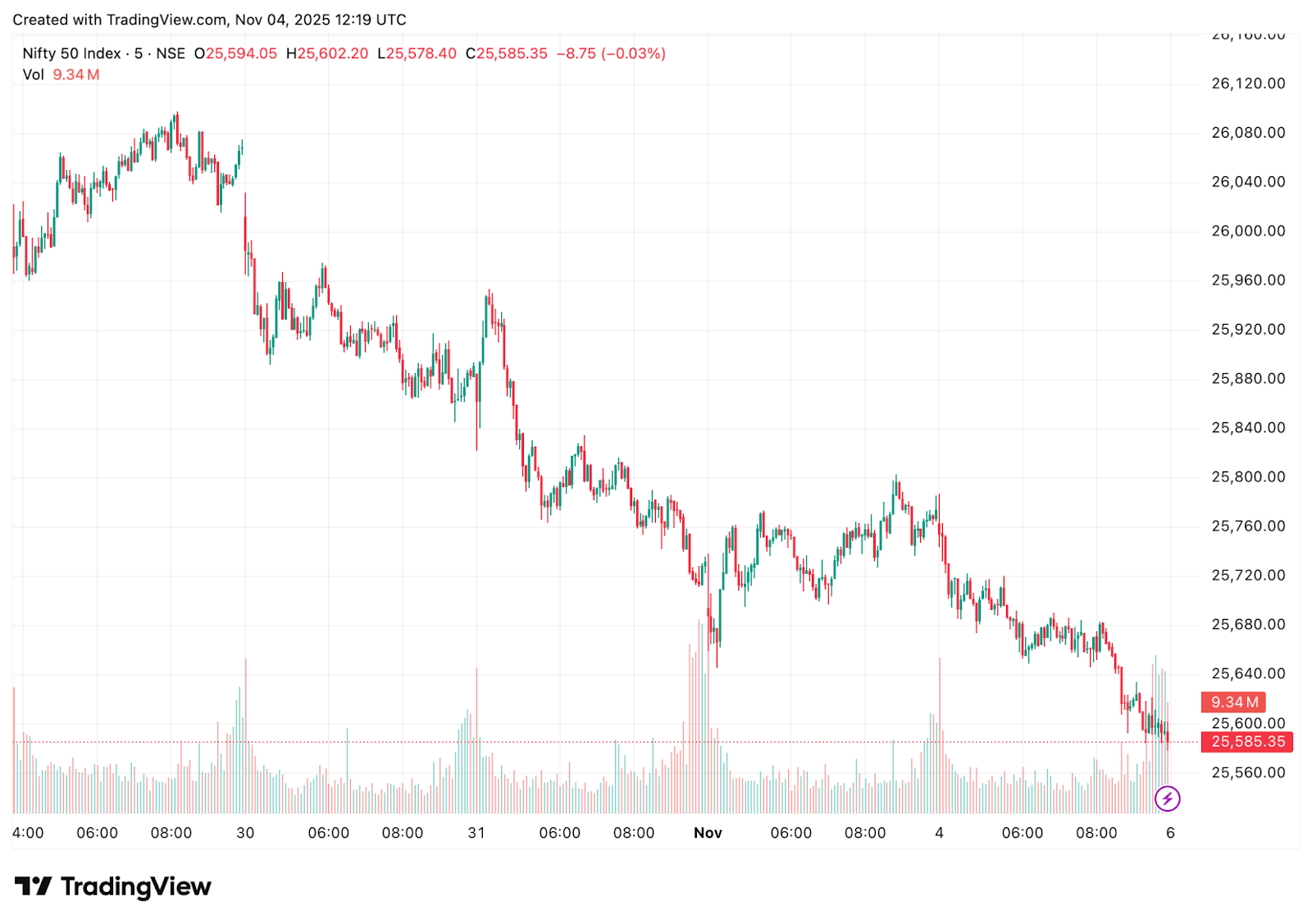The markets ended a volatile week with selective buying and cautious sentiment. How did Nifty and Sensex really perform, and what drove the moves?
From Monday, October 27, 2025- Tuesday, November 4, 2025, Indian equities reflected a week of hesitation and selective buying. As of November 4, the BSE Sensex slipped 519.34 points or 0.62% to close at 83,459.15. The Nifty50 also retreated, ending 165.70 points or 0.64% lower at 25,597.65.
Reading how the market closed this week reveals underlying sentiment rather than surface-level swings. Institutional appetite, liquidity flow and investor confidence converge to shape this rhythm. Traders interpret it as a signal of strength or fatigue, while long-term investors view it as a measure of underlying stability.
A well-curated weekly stock market recap India builds continuity in observation. It enables participants to trace evolving momentum, align strategies, and remain informed in a market that rarely pauses.
Nifty and Sensex Live Updates — What Moved the Market
The week began on Monday, October 27, 2025, with both benchmarks opening on a steady note. The Nifty 50 started at 25,843.20, rising 48.05 points or 0.19% from the previous close of 25,795.15. It moved between 25,827.00 and 25,905.30 in early trade, reflecting optimism across select sectors. The Sensex opened at 84,297.39, up 85.51 points or 0.10% from 84,211.88, supported by gains in PSU banks, realty, and oil & gas counters.
Momentum, however, faded as global sentiment turned mixed and investors booked profits ahead of domestic earnings and a shorter trading week. By November 4, the Nifty 50 had declined 0.64%, closing at 25,597.65, while the Sensex fell 0.62% to 83,459.15. Market breadth remained weak, with more stocks declining than advancing.


Sectors that drove the fall included technology, automobiles and metals, each losing between one and one and a half per cent. Consumer goods, public sector banks, and power also ended lower, shedding about half to one per cent. The only areas that maintained some resilience were consumer durables and telecom, which saw mild buying interest.
Here are the top sectors of the week, from Monday, 27 Oct 2025 to Tuesday, 4 Nov 2025.
| Date | Leading Sector(s) | Lagging Sector(s) |
| Mon, 27 Oct 2025 | PSU Bank, Realty, Oil & Gas | Media, Pharma |
| Tue, 28 Oct 2025 | Metal, PSU Bank | Realty |
| Wed, 29 Oct 2025 | Energy | Auto |
| Thu, 30 Oct 2025 | — (most sectors declined) | Private Bank |
| Fri, 31 Oct 2025 | PSU Bank | Power, Metal |
| Mon, 3 Nov 2025 | Realty, Telecom, Pharma, PSU Bank | IT |
| Tue, 4 Nov 2025 | Telecom, Consumer Durables | IT, Metal |
Top Gainers and Losers (Nifty 50)
| Date | Top Gainer (Nifty 50) | Change | Top Loser (Nifty 50) | Change |
| Mon, 27 Oct 2025 | Grasim Industries | 3.22% | Kotak Mahindra Bank | -1.74% |
| Tue, 28 Oct 2025 | Tata Steel | 2.82% | Bajaj Finserv | -1.48% |
| Wed, 29 Oct 2025 | NTPC | 2.90% | Dr. Reddy’s Laboratories | -2.40% |
| Thu, 30 Oct 2025 | Coal India | 1.58% | Dr. Reddy’s Laboratories | -3.79% |
| Fri, 31 Oct 2025 | Bharat Electronics | 3.98% | Eternal | -3.45% |
| Mon, 3 Nov 2025 | Shriram Finance | 6.20% | Maruti Suzuki | -3.41% |
| Tue, 4 Nov 2025 | Titan Company | 2.30% | Power Grid Corporation | -3.20% |
Foreign Institutional Investors (FIIs) continued to pare exposure, while Domestic Institutional Investors (DIIs) maintained steady inflows through the week. The combination of FII outflows and DII active buying contributed to mixed intra-week market swings and increased volatility.
| Date | FII Net Purchase/Sale (₹ crore) | DII Net Purchase/Sale (₹ crore) |
| 27 Oct 2025 | –55.58 | +2,492.12 |
| 28 Oct 2025 | +10,339.80 | +1,081.55 |
| 29 Oct 2025 | –2,540.16 | +5,692.81 |
| 30 Oct 2025 | –3,077.59 | +2,469.34 |
| 31 Oct 2025 | –6,769.34 | +7,068.44 |
| 03 Nov 2025 | –1,883.78 | +3,516.36 |
| 04 Nov 2025 | –1,067.01 | +1,202.90 |
Overall sentiment remained restrained, shaped by foreign fund withdrawals, mixed corporate earnings and global risk aversion. The pattern reflected investors’ preference for defensives and select accumulation rather than broad participation.
Key Drivers: Weekly Stock Market Recap India
- Earnings dictated selective movement:
Telecom and consumer names outperformed on earnings: Bharti Airtel rose after Q2 FY26 profit jumped and ARPU stayed firm; Titan advanced on a sharp profit surge aided by festive demand.
- Federal Reserve signalled restraint:
The Fed’s 25-basis-point rate cut on 29 October initially lifted risk appetite, but remarks suggesting uncertainty around a December move curbed optimism. The mixed guidance led to muted global flows into emerging markets, including India.
- Crude prices oscillated:
Brent and WTI futures slipped during the week, easing inflation concerns and import costs for India. However, supply disruptions and fluctuating demand forecasts limited energy sector gains, leaving the trend directionless.
- Profit-booking capped late-week momentum:
After a steady October rally, traders trimmed positions in financials and IT ahead of key domestic results. The caution was reinforced by persistent foreign outflows and subdued participation from institutional investors.
- Holiday-shortened week constrained activity:
The upcoming Guru Nanak Jayanti holiday on 5 November led to lower trading volumes. Shortened sessions often prompt conservative positioning, keeping intraday moves narrow and liquidity thin.
How to Get Nifty and Sensex live updates Quickly
Monitoring Nifty and Sensex movements in real time helps investors stay attuned to market direction. It highlights subtle changes in sentiment, liquidity, and institutional activity that often determine how momentum builds or fades. Staying informed through reliable channels strengthens awareness and reduces dependence on speculation.
Where to find reliable live updates
-
- NSE, BSE: provides verified, real-time data on index movement, sector performance, and market breadth
- Press Information Bureau (PIB) and SEBI – release regulatory and policy updates that often shape market sentiment
- Online and broker platforms: Such as StockEdge offer structured analytics, live charts, and sector insights in an accessible format. They combine ease of use with reliable data feeds, helping investors monitor shifts efficiently across devices.
Why timely access matters:
- Equips traders to act within narrow opportunity windows rather than after the move has passed
- Enables investors to interpret sentiment reversals and adjust allocations early
- Reinforces decision-making based on authentic data, not hearsay or delay
Accessing these online platforms through mobile applications or desktop dashboards ensures investors remain informed throughout market hours. Consistent observation sharpens judgement and builds the discipline required to navigate fast-changing conditions.
Bottomline
How the market closed this week showed a mix of caution and selective buying. Benchmark indices slipped, yet domestic flows and resilient consumer sectors offered balance. Investors largely chose stability over risk ahead of earnings and policy cues.
Staying alert through reliable online platforms keeps investors tuned to real-time shifts in sentiment and momentum. Regular tracking based on verified data sharpens timing and improves decision quality in a market that moves quickly.
DISCLAIMER: The information given in this blog is for educational purposes only. Any content of this blog is not investment advice.
- Nifty & Sensex — how to get live updates quickly - November 4, 2025
- Not Diamonds, Gold is the Indian Woman’s Best Friend Forever - October 30, 2025
- IdeaForge, Paras Defence, BEL, HAL – Defence & Drone Push Offers Compelling Narratives - October 7, 2025





